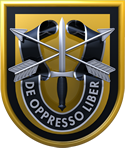1st SFG (A) History
 The 1st Special Forces Group (Airborne) lineage can be traced to the First Special Service Force. This combined Canadian – American unit, known as the “Devil’s Brigade,” distinguished itself through daring and successful raids in both the Pacific and Mediterranean theaters of operation. Detachment 101 of the Office of Strategic Services (OSS) is also considered a predecessor of the 1st SFG (A). This unit raised and led a guerrilla force known as the “Kachin Rangers,” which wrought havoc behind Japanese lines in Southeast Asia during World War II.
The 1st Special Forces Group (Airborne) lineage can be traced to the First Special Service Force. This combined Canadian – American unit, known as the “Devil’s Brigade,” distinguished itself through daring and successful raids in both the Pacific and Mediterranean theaters of operation. Detachment 101 of the Office of Strategic Services (OSS) is also considered a predecessor of the 1st SFG (A). This unit raised and led a guerrilla force known as the “Kachin Rangers,” which wrought havoc behind Japanese lines in Southeast Asia during World War II.
Reactivated at Fort Bragg on July 1, 1990, with an African and Caribbean Basin orientation, the 3rd SFG (A) returned to the Regiment. Since that time the Group has participated in numerous combat deployments as well as major training exercises, to include:The modern 1st SFG (A) was activated on June 24, 1957, and stationed at Fort Buckner, Okinawa. For the next 17 years, the 1st SFG (A) carried out a variety of missions in the Asia-Pacific region, including civic actions, foreign internal defense, counterinsurgency, reconnaissance and disaster relief. The 1st SFG (A) saw extensive combat in Vietnam as well as in Laos, Thailand and Cambodia. Soldiers from the 1st SFG (A) earned 296 awards for valor in Southeast Asia, and the group was awarded the Meritorious Unit Citation.
The 1st SFG (A) fought natural disasters as well as the enemy; teams deployed to the Philippines in 1972 and in 1973 to provide disaster relief for victims of floods and famine. For this humanitarian service, the 1st SFG (A) received the Philippines’ Presidential Unit Citation.
The 1st SFG (A) was inactivated June 28, 1974, as part of a general reduction in Special Forces strength. Ten years later, recognizing the critical role that Special Forces perform in both peace and war, the Army reactivated the 1st SFG (A).
On March 2, 1984, 1st Battalion was organized at Fort Bragg, North Carolina, and posted to Torii Station, Okinawa. The group headquarters, 2nd and 3rd Battalions, were reactivated at Fort Lewis, Washington, on September 4, 1984.
The 1st SFG (A) activated the Group Support Battalion on June 30, 2006, in order to provide increased expeditionary logistical capabilities in support of the group.
The 1st SFG (A) activated the 4th Battalion on August 15, 2011, to enhance the group’s expeditionary capabilities and better support the unit’s varied mission set.
Since September 11, 2001, the 1st SFG (A) personnel have played a vital role in fighting terrorism and violent terrorist organizations around the globe by participating in Operation Enduring Freedom – Afghanistan, Operation Enduring Freedom – Philippines, Operation Iraqi Freedom, Operation New Dawn, Operation Inherent Resolve, and Operation Resolute Support.
In the ensuing years, the 1st SFG (A) continued to conduct an array of engagement and contingency missions throughout the Pacific, to include war-plan related training on the Korean Peninsula.
Across the Special Forces community the primary mission focus continue to be overseas contingency operations. The 1st SFG (A) routinely trains, deploys, commands, sustains, and redeploys Special Forces and Special Operations Support Soldiers to sustain missions in both the U.S. Central Command and U.S. Pacific Command area of operations.
In addition to support of overseas contingency operations, the 1st SFG (A) also provides training to foreign special operations forces from partner countries within the Asia-Pacific Region. The close relationships between the 1st SFG (A) Soldiers and host-nation Special Operations Forces are critical to maintaining our successful execution of operational deployments within the USPACOM areas of responsibility.
There are more than 30 countries within the USPACOM area of responsibility and on any given day, the 1st SFG (A) has Special Forces elements conducting combined training with our partner nation Special Operations Forces.
Training with host-nation forces has evolved from just training small units on basic combat skills; our focus now is to build capacity by mentoring host- nation SOF leadership on topics such as command and control, intelligence fusion, joint operations, and sustainment.
Our foreign partners are eager to study our lessons learned from Iraq and Afghanistan. We emphasize the importance of operating in a joint, interagency, intergovernmental and multinational (JIIM) whole of government environment where the military may not be the lead agency and the 'rule of law' is non-negotiable.
Dating back to World War II and Vietnam, the 1st SFG (A), then the 1st Special Service Force (SSF), played a key role in U.S. Special Operations overseas operations.
Today, the 1st SFG (A) Soldiers continue to deploy to support conflict, training, and operational requirements, but when at home station there is always the opportunity to reflect on success of those before them and those who have paid the ultimate sacrifice.
Often, former members of the 1st SFG (A) will comment that the Special Forces Soldiers of today are much better than the Special Forces Soldiers of their era. This perception is reinforced with examples of new technology, better uniforms, more lethal weapons, and more capable communications equipment.
Special Forces Soldiers that came before us, despite the absence of modern equipment and weapon systems, accomplished their missions and earned the respect and admiration that the 1st SFG (A) enjoys today; the old adage remains true today as it was in 1942 and 1957; “it's not the beret, it’s the heart and character of the Soldiers that wear them.”

